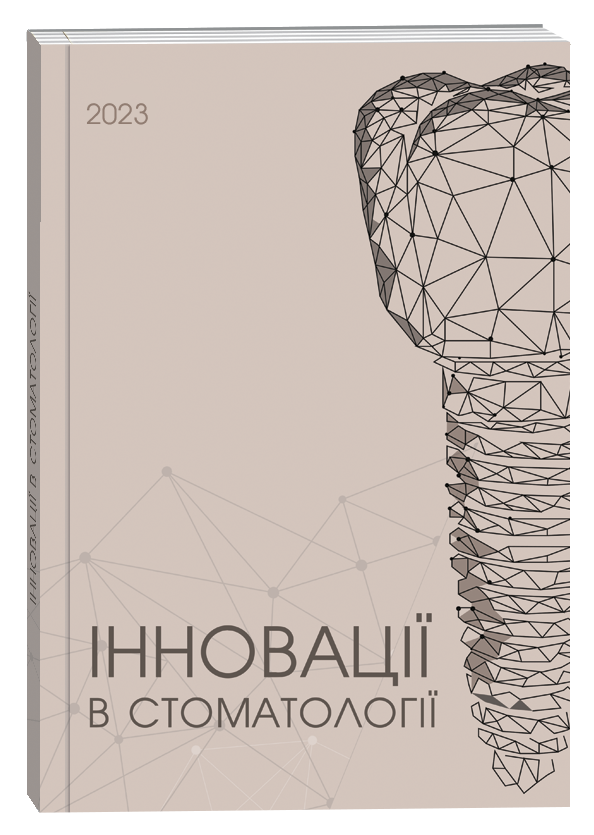DISTINCTIVE ASPECTS OF CANDIDAL STOMATITIS TREATMENT IN THE PRESENCE OF CONCURRENT MEDICAL CONDITIONS
DOI:
https://doi.org/10.35220/2523-420X/2023.1.6Keywords:
recurrent candidal stomatitis, chronic viral hepatitis B, treatment, CANDIVACAbstract
Purpose of the study. To study the effectiveness of the treatment complex, which includes CANDIVAC in patients with manifestations of candidal lesions of the oral mucosa with a recurrent course on the back of chronic viral hepatitis B in the replication phase. Research methods. Patients with chronic viral hepatitis B (CHBV) in the replication phase, who were diagnosed microscopically and through laboratory tests with 4 cases of candidal stomatitis over the past 12 months, were subject to observation. The diagnosis of recurrent candidal stomatitis was substantiated on the basis of clinical manifestations and microscopic and bacteriological examination of pathological material from the lesion. The effectiveness of therapy was monitored immediately before the appointment of CANDIVAC and 21 days after the start of treatment, and was also repeated in 9 and 12 months. Scientific novelty. The dynamics of subjective complaints and microbiological studies showed positive changes during treatment, namely: already after 21 days of treatment, 64 % of the examined patients noted the disappearance of the symptoms of the disease, and there was also no pathogen in smears from the oral cavity and in the intestine. It is worth noting that in persons with CVHB, in whom the replication phase lasted no more than 2 years, a more pronounced effect of the treatment complex was recorded. Analysis of the effectiveness of medical examinations 9 and 12 months after the introduction of CANDIVAC showed a significant improvement in the assessment of subjective complaints and microbiological parameters. At the same time, in patients with CVHB who had a replication phase of more than 5 years, the reduction of contamination of the oral and intestinal mucosa was less effective. Conclusions. The data obtained indicate a favorable effect of CANDIVAC in the complex treatment of the recurrent course of candidal stomatitis, which led to a statistically significant decrease in the frequency of relapses and the intensity of patients' subjective complaints.
References
Gordijuk, M.M., Fesenko, V.I., & Fesenko, V.I. (2010). Kandydoz shlunkovo-kyshkovogo traktu ta porozhnyny rota: diagnostyka ta likuvannja: navchal'nyj posibnyk -3-tje vyd [Candidiasis of the gastrointestinal tract and oral cavity: diagnosis and treatment: textbook-3rd type].Dnipropetrovs'k: Porogy [in Ukrainian].
Peter G. Pappas, John H. Rex, Jack D. Sobel, Scott G. Filler, William E. Dismukes, Thomas J. Walsh, & John E. Edwards. (2004). Guidelines for Treatment of Candidiasis. Clinical Infectious Diseases, 38, 2(15), 161–189, юdoi.org/10.1086/380796.
Levyc'kyj, A.P., & Dem’janenko, S.A. (2012). Gepatooral'nyj syndrom [Hepatorenal syndrome]. Symferopol' [in Ukrainian].
Fesenko, V.I., & Shvec', S.V. (2016). Pokaznyky biocenozu parodontal'nyh kyshen' ta imunologichnogo statusu u hvoryh na parodontyt, asocijovanyj -HBV infekcijeju [Indicators of periodontal pocket biocenosis and immunological status in patients with periodontitis associated with HBV infection]. – Przemysl : Мат. XIImiedzynarodo-wejnaukowi – ptaktycznejkonferencji, 3, 24-30 [in Ukrainian].
Costa, R., Poluha, R., Canales, G. & et al. (2020). The effectiveness of microwave disinfection in treating Candida-associated denture stomatitis: a systematic review and metaanalysis. Clinical Oral Investigations, 24(11), 3821-3832 doi: 10.1007/s00784-020-03599-5.
Mardani Maryam, & Omid Kamrani (2021). Effectiveness of antimicrobial photodynamic therapy wit hindocyanine green against the standard an fluconazoleresistant Candida albicans. Lasers in Medical Science, 36(9), 1971-1977. doi: 10.1007/s10103-021-03389-92021.
Naglik, J. R. (2017). Candida albicans-epithelial interactions and induction of mucosal innate immunity. Curr Opin Microbiol, 40, 104–112. doi: 10.1016/j.mib.2017.10.030.
Rodrigues, C. F., Rodrigues, M. E., & Henriques, M. (2019). Candida sp. Infections in Patients with Diabetes Mellitus. J. Clin Med. Jan; 8(1), 76. doi: 10.3390/jcm8010076.
Silva, S., Rodrigues, C. F., Araújo, Daniela & et al. (2017). Candida Species Biofilms’ Antifungal Resistance. J Fungi (Basel). Mar; 3(1), 8. doi: 10.3390/jof301000.
Hung-Jen Tang, Wei-Lun Liu, Hsin-Lan Lin, Chih-Cheng Lai. Epidemiology and prognostic factors of candidemia in elderly patients. Geriatr Gerontol Int 2015 Jun;15(6). P. 688-93 doi: 10.1111/ggi.12329.
Tarçın, BG. (2011). Oral candidosis: aetiology, clinical manifestations, diagnosis and management. Müsbed, 1(2), 140-148.
Terayama, Y., Matsuura, T., Uchida, M., Narama, I., & Ozaki, K. (2016). Probiotic (yogurt) containing Lactobacillus gasseri OLL2716 is effective for preventing Candida albicans-induced mucosal inflammation and proliferation in the forestomach of diabetic rats. Histol. Histopathol, 31, 689–697 doi: 10.14670/HH-11-710.
Unzeitig, V., Stará, A., Dvorák, J., & Nový, J. (2013). Use of the CANDIVAC cps. yeast plant lyophilisate in females with recurrent vulvovaginal candidiasis: Clinical study results. Pediatria i Medycyna Rodzinna, 9(4), 404-407.
Vrzal, V., Bittner, L., & Nepereny, J. (2015). Use of yeast lysate in women with recurrent vulvovaginal Candidiasis. Procedia in Vaccinology, 9, 35–37 doi.org/10.1016/j.provac.2015.05.006.
Zabara, A., Al-Akwa, A., Al-Shamahy, H. & et al. (2020). Oral Non-Candida Albicans Species Colonization rate in Fixed Orthodontics Patients. International Journal of Dentistry and Oral Health, 6, 6.








